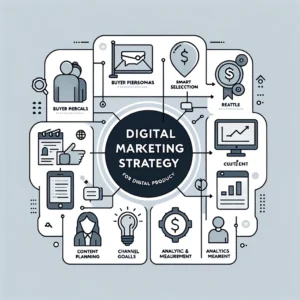Product development is a crucial aspect of any business, as it involves creating and improving products to meet the ever-changing needs and preferences of customers. A well-defined product development strategy can give companies a competitive edge in the market, drive growth, and increase customer satisfaction. In this article, we will explore the key elements of a successful product development strategy, discuss various approaches, and provide real-world examples to illustrate their effectiveness.

The Importance of a Product Development Strategy
A product development strategy serves as a roadmap for businesses to introduce new products or enhance existing ones. It helps companies align their efforts with market demands, customer expectations, and technological advancements. By having a clear strategy in place, businesses can minimize risks, optimize resources, and maximize the chances of success.
Furthermore, a well-executed product development strategy can lead to several benefits:
- Increased market share: By continuously developing innovative products, companies can attract new customers and gain a larger share of the market.
- Enhanced customer loyalty: Developing products that address specific customer needs and preferences can foster loyalty and long-term relationships.
- Improved profitability: Successful product development can lead to higher sales, increased revenue, and improved profitability.
- Competitive advantage: A well-defined product development strategy can differentiate a company from its competitors and establish it as an industry leader.
Key Elements of a Successful Product Development Strategy
A successful product development strategy encompasses several key elements that work together to drive innovation and growth. Let’s explore each of these elements in detail:
1. Market Research and Analysis
Market research is a critical first step in developing a product development strategy. It involves gathering and analyzing data about the target market, customer needs, and competitors. By understanding market trends, customer preferences, and gaps in the market, businesses can identify opportunities for product development.
For example, Apple Inc. conducts extensive market research to identify emerging technology trends and consumer demands. This research helps them develop innovative products like the iPhone, iPad, and Apple Watch, which have revolutionized the tech industry.
2. Setting Clear Objectives
Setting clear objectives is essential for guiding the product development process. Objectives should be specific, measurable, achievable, relevant, and time-bound (SMART). They provide a clear direction and help teams stay focused on their goals.
For instance, Tesla’s objective for its product development strategy is to accelerate the world’s transition to sustainable energy. This objective guides their efforts in developing electric vehicles and renewable energy solutions.
3. Idea Generation and Screening
Idea generation involves brainstorming and gathering potential product ideas. This can be done through internal brainstorming sessions, customer feedback, market research, or collaborations with external partners. Once ideas are generated, they need to be screened and evaluated based on various criteria such as market potential, feasibility, and alignment with the company’s objectives.
Google’s “20% time” policy is a prime example of encouraging idea generation. Employees are allowed to spend 20% of their work time on projects of their choice, which has led to the development of successful products like Gmail and Google Maps.
4. Concept Development and Testing
Once a promising idea is identified, it needs to be developed into a concept. This involves creating prototypes, conducting market research, and gathering feedback from potential customers. Concept testing helps validate the viability and appeal of the product before investing significant resources into its development.
One notable example is the concept development and testing of the Amazon Kindle. Amazon conducted extensive user testing to refine the design and features of the e-reader, ensuring it met the needs and preferences of book lovers.
5. Product Design and Development
Product design and development involve transforming the concept into a tangible product. This stage includes engineering, manufacturing, packaging, and quality assurance. Collaboration between cross-functional teams is crucial to ensure the product meets technical specifications, cost targets, and timeframes.
Apple’s product design and development process is renowned for its attention to detail and user experience. Their products are known for their sleek design, intuitive interfaces, and seamless integration of hardware and software.
6. Test Marketing and Launch
Before a product is launched to the mass market, test marketing can be conducted to gather feedback and assess its performance. Test marketing involves introducing the product to a limited audience or specific geographic area. The results and feedback obtained during this phase can help fine-tune the product and marketing strategy before the full-scale launch.
For example, Coca-Cola introduced its “New Coke” through test marketing in select markets before its nationwide launch. The negative feedback received during the test marketing phase led to the decision to revert to the original formula, highlighting the importance of test marketing in avoiding costly mistakes.
7. Continuous Improvement and Innovation
Product development is an ongoing process that requires continuous improvement and innovation. Companies should gather customer feedback, monitor market trends, and stay updated with technological advancements to identify opportunities for product enhancements or new product development.
Netflix is a prime example of a company that embraces continuous improvement and innovation. They constantly analyze user data, conduct A/B testing, and invest in original content to enhance their streaming platform and stay ahead of competitors.
Choosing the Right Product Development Strategy
There are various product development strategies that businesses can adopt based on their goals, resources, and market conditions. Let’s explore some of the commonly used strategies:
1. Market Expansion
Market expansion involves introducing existing products into new markets or targeting new customer segments. This strategy allows businesses to leverage their existing products’ success and capitalize on untapped opportunities.
For instance, McDonald’s successfully expanded its market by introducing its fast-food restaurants in various countries worldwide. By adapting their menu and marketing strategies to suit local preferences, they were able to cater to a diverse customer base.
2. Product Line Extension
Product line extension involves adding new products to an existing product line to meet different customer needs or preferences. This strategy allows businesses to leverage their brand equity, distribution channels, and customer base.
An example of product line extension is the introduction of different flavors or variations of a popular snack. Lay’s, a well-known potato chip brand, offers a wide range of flavors to cater to diverse consumer tastes.
3. Product Improvement
Product improvement focuses on enhancing existing products to make them more appealing, functional, or technologically advanced. This strategy aims to address customer feedback, stay ahead of competitors, and extend the product’s lifecycle.
Automobile manufacturers often adopt this strategy by introducing upgraded models with improved features, fuel efficiency, and safety enhancements. For example, Toyota continuously improves its hybrid vehicles to enhance performance and reduce emissions.
4. New Product Development
New product development involves creating and introducing entirely new products to the market. This strategy requires significant investment in research, development, and marketing but can lead to substantial rewards if successful.
One notable example is the launch of the iPhone by Apple. The iPhone revolutionized the mobile phone industry by combining a phone, music player, and internet device into one sleek package.
Conclusion
A well-defined product development strategy is essential for businesses to stay competitive, drive growth, and meet customer expectations. By conducting thorough market research, setting clear objectives, generating and screening ideas, developing concepts, designing and developing products, conducting test marketing, and embracing continuous improvement, companies can create successful products that resonate with their target audience.
Choosing the right product development strategy, whether it’s market expansion, product line extension, product improvement, or new product development, depends on the company’s goals, resources, and market conditions. By adopting a strategic approach to product development, businesses can increase their chances of success and achieve sustainable growth in today’s dynamic marketplace.




